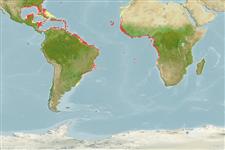>
Eupercaria/misc (Various families in series Eupercaria) >
Gerreidae (Mojarras)
Etymology: Eucinostomus: Greek, eu = good + Greek, kyon = dog + Greek, stoma = mouth (Ref. 45335).
More on author: Bleeker.
Environment: milieu / climate zone / depth range / distribution range
นิเวศวิทยา
เกี่ยวกับทะเล,น้ำเค็ม; น้ำจืด; กร่อย สัตว์น้ำหน้าดิน; สัตว์น้ำที่อพยพไปๆมาๆ ระหว่างแหล่งน้ำจืดกับทะเล ที่เป็นไปตามช่วงชีวิต (Ref. 51243); ระดับความลึก 0 - 25 m (Ref. 2683). Subtropical; 33°N - 34°S, 98°W - 14°E
Eastern Atlantic: west African coast, from Senegal to Angola (Ref. 57394). Also reported from Mauritania (Ref. 5377, 7352). Western Atlantic: Bermuda and Florida, USA to Brazil; not found in the Bahamas (Ref. 7251).
ขนาด / น้ำหนัก / Age
Maturity: Lm ? range ? - ? cm
Max length : 30.0 cm TL เพศผู้/กระเทย; (Ref. 2683); common length : 23.0 cm TL เพศผู้/กระเทย; (Ref. 2683); น้ำหนักสูงสุดที่มีการรายงาน: 26.50 g (Ref. 118626)
Short description
สัณฐานวิทยา | ความยาวต่างๆ
เงี่ยงครีบหลัง (รวม): 9; ก้านครีบอ่อนที่หาง (รวม): 10; เงี่ยงครีบก้น 3; ก้านครีบอ่อนที่ก้น: 7 - 8. Diagnosis: body fusiform and compressed; snout pointed; mouth strongly protrusible; nostrils contiguous, positioned nearer to eye than to snout tip; dorsal fin deeply notched; tips of pectoral fins not reaching to anal-fin origin; scales cycloid on head and finely ctenoid on body; scales of interocular space reaching anterior border of eyes; tip of spinous dorsal fin with a black spot, underlined by a whitish band (Ref. 57394).
Coloration: back olivaceous, sides silvery; a characteristic black spot at tip of spiny part of dorsal fin; young individuals may show dark vertical bars on back and sides (Ref. 57394).
A coastal species entering estuaries, lower courses of coastal rivers, and lagoons (Ref. 4323, 7352, 57394). Found over sand or mud bottoms (Ref. 3722, 57394). Feeds on fish, shrimps, mollusks, zooplankton and detritus (Ref. 28587); including other benthic crustaceans and polychaetes. Forages at daytime in small groups, hovering close to the bottom and either picks off prey on the substrate or digs into it sifting the mouthed sediment through its opercular openings. Its conspicuous black tip on dorsal fin is mimicked by juvenile guianan snooks, Centropomus mexicanus, an example of aggressive mimicry (Ref. 43465). Marketed fresh but not highly esteemed (Ref. 3722).
Life cycle and mating behavior
วัยเจริญพันธุ์ | การสืบพันธุ์ | การวางไข่ | เซลสืบพันธ์ของเพศเมีย(ไข่) | ความดกของไข่ | ตัวอ่อน
Roux, C., 1990. Gerridae. p. 781-782. In J.C. Quero, J.C. Hureau, C. Karrer, A. Post and L. Saldanha (eds.) Check-list of the fishes of the eastern tropical Atlantic (CLOFETA). JNICT, Lisbon; SEI, Paris; and UNESCO, Paris. Vol. 2. (Ref. 7352)
IUCN Red List Status (Ref. 130435)
Threat to humans
Harmless
Human uses
การประมง: มีการค้าเพียงเล็กน้อย
ข้อมูลเพิ่มเติม
ชื่อสามัญชื่อพ้องกลไกการเผาผลาญพลังงานผู้ล่าการศึกษาเกี่ยวกับผลกระทบของสารประกอบทางเคมีที่เป็นอันตรายต่อสิ่งมีชีวิต ประชากร และสิ่งแวดล้อมการสืบพันธุ์วัยเจริญพันธุ์การวางไข่การรวมกลุ่มวางไข่ความดกของไข่เซลสืบพันธ์ของเพศเมีย(ไข่)Egg development
อ้างอิงการเพาะเลี้ยงสัตว์น้ำประวัติการเพาะเลี้ยงสัตว์น้ำสายพันธุ์พันธุศาสตร์ElectrophoresesอัตราพันธุกรรมโรคการแปรรูปNutrientsMass conversion
ผู้ร่วมมือรูปภาพหลายรูปStamps, Coins Misc.เสียงปลามีพิษ เช่น ปลาปักเป้าความเร็วรูปแบบการว่ายน้ำพื้นที่เหงือกOtolithsสมองวิสัยทัศน์
เครื่องมือ
Special reports
Download XML
แหล่งที่มาจากอินเตอร์เน็ต
Estimates based on models
Preferred temperature (Ref.
123201): 23.4 - 28, mean 27.1 °C (based on 1079 cells).
Phylogenetic diversity index (Ref.
82804): PD
50 = 0.5010 [Uniqueness, from 0.5 = low to 2.0 = high].
Bayesian length-weight: a=0.01047 (0.00829 - 0.01322), b=3.08 (3.04 - 3.12), in cm total length, based on LWR estimates for this species (Ref.
93245).
ระดับชั้นอาหาร (Ref.
69278): 3.4 ±0.52 se; based on food items.
ความสามารถในการกลับคืนสู่ปกติ (Ref.
120179): ความสูง, เวลาต่ำสุดที่จะทำให้ประชากรเพิ่มขึ้นเป็น 2 เท่าใช้เวลาน้อยกว่า 15 เดือน (Preliminary K or Fecundity.).
Fishing Vulnerability (Ref.
59153): Low vulnerability (20 of 100).
Nutrients (Ref.
124155): Calcium = 117 [60, 236] mg/100g; Iron = 1.11 [0.58, 2.04] mg/100g; Protein = 19.5 [17.6, 21.3] %; Omega3 = 0.365 [0.198, 0.650] g/100g; Selenium = 18.3 [9.5, 36.3] μg/100g; VitaminA = 11.8 [3.7, 32.6] μg/100g; Zinc = 1.01 [0.70, 1.44] mg/100g (wet weight);
